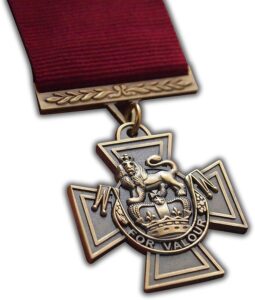 Victoria Cross Recipients in the Indian Mutiny
Victoria Cross Recipients in the Indian Mutiny
Many people will be familiar with the Ulstermen who were awarded the Victoria Cross during the world wars of the twentieth century. Men like William Frederick McFadzean and Robert Quigg in the Great War and James Joseph Magennis in the Second World War. However, Ulstermen who received the ultimate accolade for gallantry in the nineteenth century are often overlooked, if not, forgotten. This is the story of three men who were awarded the Victoria Cross in the Indian Mutiny. Two are commemorated in physical forms and one is not.
In 1881, the Childers Army Reform resulted in the “Regiments of Foot” being re-fashioned as two-battalion regional regiments – for example the 27th and 108th Regiments of Foot became the Royal Inniskilling Fusiliers, the 83rd and 86th became the Royal Irish Rifles, and the 87th and 89th became the Royal Irish Fusiliers. A footnote gives the later names of the regiments referred to in this article.
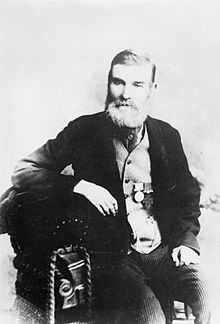 Patrick Carlin was born in Shankill Parish in 1832 to Patrick Carlin and was a labourer when he enlisted with the Queen’s Royal (Antrim Rifles) Regiment of Militia on 5th December 1854. He was released from this engagement in order to enlist with the 13th (1st Somersetshire) Regiment of Foot in Belfast on 8th May 1855 at the age of 23. He served in Malta (7 months), Crimea (3 months), Gibraltar (4 years and four months), Cape Colony (1 year and one month) and India (6 years and 6 months).
Patrick Carlin was born in Shankill Parish in 1832 to Patrick Carlin and was a labourer when he enlisted with the Queen’s Royal (Antrim Rifles) Regiment of Militia on 5th December 1854. He was released from this engagement in order to enlist with the 13th (1st Somersetshire) Regiment of Foot in Belfast on 8th May 1855 at the age of 23. He served in Malta (7 months), Crimea (3 months), Gibraltar (4 years and four months), Cape Colony (1 year and one month) and India (6 years and 6 months).
A General Order issued on 29th June 1858, General Colin Campbell, Commander-in-Chief of India, recorded: “The Commander-in-Chief in India directs that the undermentioned Soldier, of the 13th Foot, be presented, in the name of Her Most Gracious Majesty, with a Medal of the Victoria Cross, for valour and daring in the field, viz.: Private Patrick Carlin, No. 3611, of the 13th Foot, for rescuing, on the 6th of April, 1858, a wounded Naick of the 4th Madras Rifles, in the field of battle, after killing, with the Naick’s sword, a mutineer sepoy, who fired at him whilst bearing off his wounded comrade on his shoulders.” The Victoria Cross was awarded to two men from the 13th Regiment of Foot for their actions in the same engagements and these were the first Victoria Cross awards for the regiment.
He was also awarded the Indian Mutiny Medal and, following a severe fracture of the right femur, was invalided out of the army in September 1871, having served for over 16 years.
Patrick Carlin was living at Alexander Street West when he married Catherine Hagans of English Street on 6th September 1872 at the Roman Catholic Chapel of St Peter’s in the Lower Falls area. They were living at 57 Irwin Street, which ran between Cullingtree Road and Milford Street, when Patrick was admitted to the Workhouse Infirmary, where he died on 11th May 1895 following a series of seizures over a 24-hour period. The entry in the Register of Deaths records that he was 51 years old but the details in the military records indicate that he was 63. Online sources record that he is buried in an unmarked grave in Friar’s Bush Graveyard. David Gourley and Mervyn Craig from the Ulster Covenant Historical Society have been campaigning for several years for a memorial to be erected in the grounds of the graveyard.
Patrick Carlin’s Victoria Cross is displayed at the Somersetshire Light Infantry Museum at Taunton Castle.
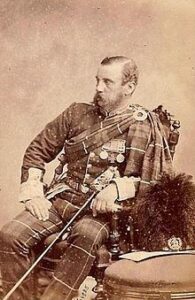 Valentine Munbee McMaster was born on 16th May 1834 at Trichinopoly in British India to Major General Bryce McMaster and Mary Letitia McMaster (nee Munbee). His father died on 8th July 1845 at Karnataka, Bangalore, India. Valentine McMaster graduated from the University of Edinburgh Medical School with a Doctorate in Medicine. Valentine McMaster served as an assistant surgeon with the 78th (Highlanders) Regiment of Foot. He was 23 years old when he was awarded the Victoria Cross for his actions at the Siege of Lucknow. The citation, published in the London Gazette on 18th June 1858, read, “For the intrepidity with which he exposed himself to the fire of the enemy, in bringing in, and attending to, the wounded, on the 25th of September, at Lucknow.” Valentine McMaster was the second man from the 78th Regiment of Foot to be awarded the Victoria Cross.
Valentine Munbee McMaster was born on 16th May 1834 at Trichinopoly in British India to Major General Bryce McMaster and Mary Letitia McMaster (nee Munbee). His father died on 8th July 1845 at Karnataka, Bangalore, India. Valentine McMaster graduated from the University of Edinburgh Medical School with a Doctorate in Medicine. Valentine McMaster served as an assistant surgeon with the 78th (Highlanders) Regiment of Foot. He was 23 years old when he was awarded the Victoria Cross for his actions at the Siege of Lucknow. The citation, published in the London Gazette on 18th June 1858, read, “For the intrepidity with which he exposed himself to the fire of the enemy, in bringing in, and attending to, the wounded, on the 25th of September, at Lucknow.” Valentine McMaster was the second man from the 78th Regiment of Foot to be awarded the Victoria Cross.
Valentine McMaster, who was also awarded the Indian Mutiny Medal, married Eleanor Ann Burmester on 10th May 1871 at Halifax in Nova Scotia. Valentine McMaster held the rank of Surgeon when he died of valvular heart disease in the hospital at Victoria Barracks in Belfast on 22nd January 1872, aged 37. He was buried in Belfast City Cemetery three days later and a simple cross was erected at the grave by his widow. The Officers, Non-Commissioned Officers, and Privates of his regiment erected an elaborate memorial tablet in St Columb’s Cathedral in Londonderry.
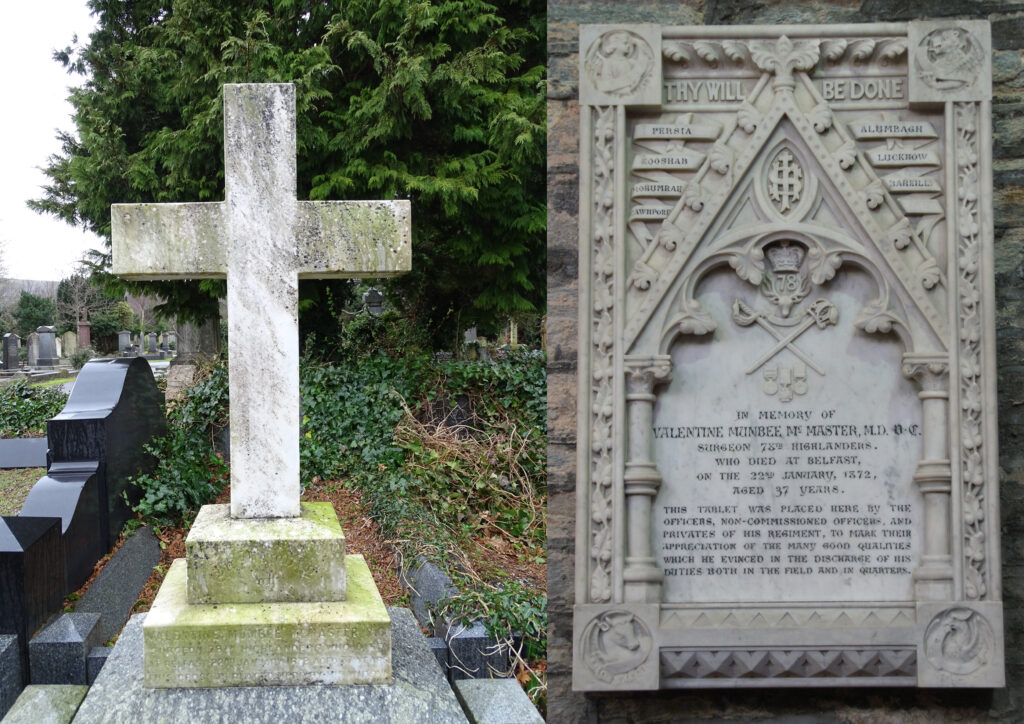 His widow later married Campbell Mellis Douglas, who had been awarded the Victoria Cross in 1867.
His widow later married Campbell Mellis Douglas, who had been awarded the Victoria Cross in 1867.
Valentine Munbee McMaster’s Victoria Cross is displayed at the National War Museum of Scotland in Edinburgh Castle.
Bernard McQuirt
Bernard McQuirt was born around 1829 in Donaghcloney in County Armagh and he enlisted with the 95th (Derbyshire) Regiment of Foot on 5th October 1854 at the age of 25. He served in Malta (1 month), Crimea (1 year and 2 months, being awarded the Crimea campaign medal with the Sevastopol Clasp) and India (1 year and 1 month).
Bernard McQuirt was 29 when he was awarded the Victoria Cross for his actions during the capture of the town of Rowa. He was the first man from the regiment to be awarded the Victoria Cross, with the citation being published in the London Gazette on 11th November 1859:
“For gallant conduct on the 6th of January 1858, at the capture of the entrenched town of Rowa, when he was severely and dangerously wounded in a hand to hand fight with three men, of whom he killed one and wounded another. He received five sabre cuts and a musket shot in this service.”
Due to the severity of the wounds sustained in the engagement, he was medically discharged on 5th July 1859, having served for four years and 231 days. He was invested with the Victoria Cross by Queen Victoria at Windsor Castle on 4th January 1860, almost 2 years after his action. Bernard McQuirt (aka McCourt) died of chronic bronchits at his home in Urney Street on 5th October 1888. He was buried in one of the Public (or Poor Ground) Sections in Belfast City Cemetery on 7th October, his surname being recorded as McCourt in the cemetery records. As there could be several bodies buried in the same plot, his final resting place is not marked by a gravestone. However, a memorial gravestone was erected in the graveyard in Donaghcloney in recent years and he is commemorated on a recumbent plaque at Donaghcloney War Memorial.
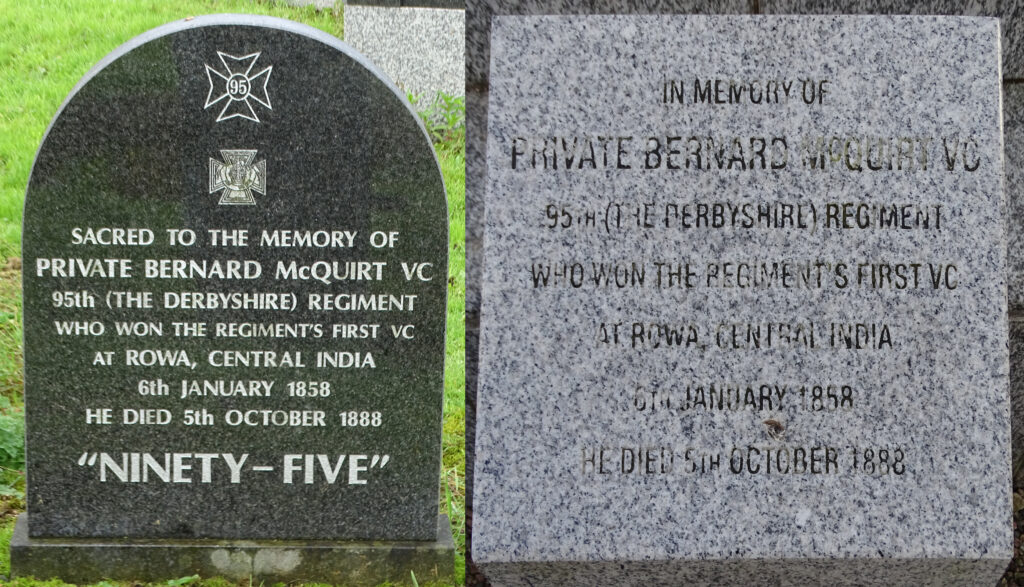 Bernard’s age is recorded as 50 in the Register of Deaths and in the cemetery records, but the military sources indicate that he was 59 when he died.
Bernard’s age is recorded as 50 in the Register of Deaths and in the cemetery records, but the military sources indicate that he was 59 when he died.
The location of his Victoria Cross is not known.
Childers Army Reforms (1881)
The 13th (1st Somersetshire) Regiment of Foot became the Somerset Light Infantry.
The 78th (Highlanders) Regiment of Foot amalgamated with the 72nd Regiment of Foot to form the Seaforth Highlanders.
The 95th (Derbyshire) Regiment of Foot amalgamated with the 45th (Nottinghamshire) Regiment of Foot to become the Sherwood Foresters (The Nottinghamshire and Derbyshire Regiment)
